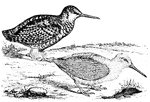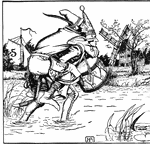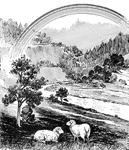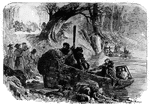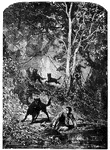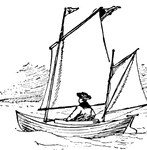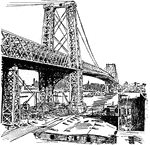
George Inness
(1825-1894) Painter whose works reflected the Hudson River school and later became an Impressionist.

General Kuroki
(1844-1923) Japanese general. He was the head of the Japanese First Army during the Russo-Japanese War;…
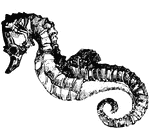
Seahorse
The seahorse is the only fish as yet known to have a prehensile tail. It has been found in the Hudson…

Achilles
Son of Peleus, king of the Myrmidons. Hero of the Trojan War. Thetis is said to have dipped him, while…
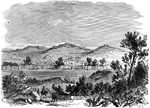
Saratoga and Stillwater - Encampments of Burgoyne's Army
Encampments of Burgoyne's army, Saratoga and Stillwater.
New East River Bridge, NY
The New East River Bridge is located in New York. It is often called the Brooklyn Bridge. It is the…

Hippopotamus
The Hippopotamus is the river horse of Africa, a genus of a family of ungulates, which contains only…
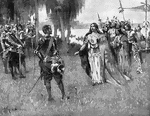
De Soto and the Indian Queen
On the 1st of May the Indian Queen crossed the river in a canoe. She presented De Soto with skins, shawls,…

East River Bridge
The suspension-bridge over the strait called the East river, which seperates New York and Brooklyn was…

Discovery of a Confederate Battery at Messech's Point
The activity of the Confederates on the Potomac and the confluent rivers was almost incredible. In one…

The Great Naval Battle on the Mississippi
First day's bombardment, Federal Schooners off Forts Jackson and St. Philip, commanding the passage…

The Great Naval Battle of the Mississippi
Passage of the second division of the Federal Squadron past Fort St. Philip. On April 24, 1862 at three…

Fort Pulaski
Fort Pulaski, on Cockspur Island at the entrance to the Savannah River, Georgia, was built by the United…

Camp Lillie
Headquarters of General Freemont, Jefferson City, Missouri, October 1, 1861. Jefferson City is on the…
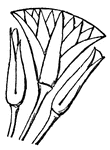
Conventionalized Lotus Flower
The lotus flower has been called the sacred flower of Ancient Egypt. As a product of the life-giving,…
!["[African American] drivers of the baggage train attached to General Pleasonton's Cavalry brigade watering their mules in the Rappahannock. General Pleasonton's cavalry was attended by a very efficient forage brigade, consisting of mules and [African American] riders. Our sketch represents their drivers taking them to water at the river. The hard work these animals will endure is something wonderful, and justifies the high estimation in which they are held in the army." — Frank Leslie, 1896](https://etc.usf.edu/clipart/11000/11025/baggagetrain_11025_mth.gif)
Baggage Train
"[African American] drivers of the baggage train attached to General Pleasonton's Cavalry brigade watering…

Old Church
"Desperate skirmish at Old Church, near Tunstall's Station, VA., between a squadron of the Fifth United…

Westfield
"Fire raft sent down from Fort Jackson to destroy the Federal fleet below the fort- the boats of the…
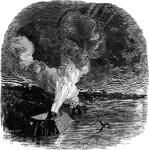
Siege of Island
"Siege of Island No. 10, on the Mississippi River- night bombardment by the Federal mortar boats, ten…

Great Falls
"Shelling Confederate cavalry across the Potomac River from the heights of Great Falls, by Major West,…

Pontoon bridge
"General Fremont's Division crossing the Pontoon Bridge over the Shenandoah River in pursuit of the…

First naval battle
"First naval battle in Hampton Roads between the Confederate iron-plated steamers Merrimac, Yorktown,…

Second Naval Battle
"Second naval battle in Hampton Roads- fight between the Federal ironclad Monitor, of two guns,…

Burning of the White House
"Burning of the White House- the Federal troops, by command of General McClellan, abandoning their position…

Camp Dennison
"Camp Dennison, sixteen miles above Cincinnati, on the banks of the Miami River, General Cox commanding-…

Battle at Potomac
"Engagement between the Federal troops and the Confederates on the Virginia side of the Potomac, opposite…

Michael Corcoran
"General Michael Corcoran, born in Carrowkeel, County Sligo, Ireland, September 21st, 1827, died near…

Battle of Mill Spring
"Battle of Mill Spring, on the Cumberland River, near Jamestown, between a confederate force, 8,000…

Crossing of Shenandoah River
"Colonel Pilson's Battery shelling the rear guard of the Confederate General Jackson's Army, at the…

Bouquet Battery
"The Bouquet Battery, commanding the viaduct over the Patapsco River, on the Baltimore and Ohio Railroad,…
Federal Fleet
"Panoramic view of the Federal fleet passing the forts of the Mississippi, on its way to New Orleans,…

Ellsworth's Zouaves
"The departure of Colonel Ellsworth's Zouaves from New york, escorted by the fire department- the regiment…

Edward's Ferry
"Successful retreat of the Federal troops from the Virginia shore across a canal-boat bridge at Edward's…
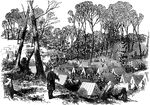
Camp of Ninth Massachusetts
"Camp of the Ninth Massachusetts Regiment in the woods, one mile from the Confederate fortifications,…
!["A detachment of the First South Carolina [African American] Federal Volunteers, under the command of Colonel Beard, repelling the attack of Confederate troops in the vicinity of Doboy River, GA." —Leslie, 1896](https://etc.usf.edu/clipart/11200/11251/doboy_11251_mth.gif)
Doboy River
"A detachment of the First South Carolina [African American] Federal Volunteers, under the command of…

Fort Thompson
"View of New Berne, N. C., from the interior of Fort Thompson after its capture by the Federal forces-…

Combat at Yazoo River
"Desperate naval combat between the Confederate iron-plated ram Arkansas and the Federal gunboat…

James Island
"Repulse of the Confederates at James Island, near Charleston, S. C., June 10th, 1862, in the attempt…

Bellaire, Ohio
"Bellaire, O.- Steamboats conveying troops and munitions of war for the Federal forces on the Great…

Kentucky Raid
"The Confederate raid into Kentucky- the fight at the Licking Bridge, Cynthiana, between the Federal…

Battle of Malvern Hill
"Battle of Malvern Hill, near Turkey Bend, James River, Va., fought Tuesday, July 1st, 1862. The battle…







